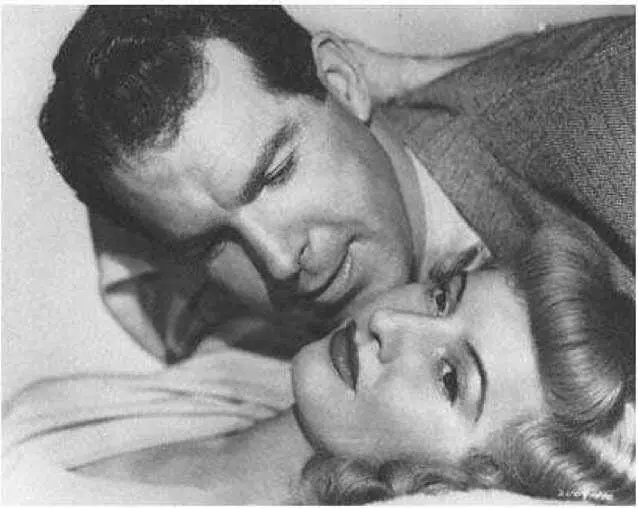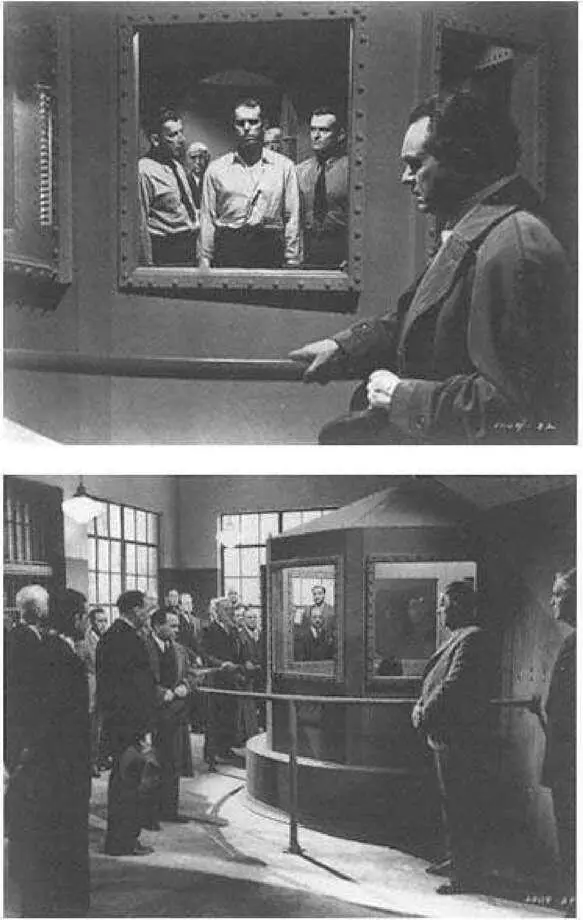
"She was perfect. No nerves, not a tear, not even a blink of the eye."
(Museum of Modern Art Stills Archive.)
Schickel admires this ending, but he is incorrect when he suggests that Wilder invented it as a substitute for the execution scene (6364). Actually, there were three possible conclusions to Double Indemnity, and none of them involved new material. According to the final drafts of the screenplay in the Motion Picture Academy Library in Los Angeles, the released print is merely a bit shorter than the other two possibilities, omitting not only the execution sequence but also a line of dialogue that was spoken by Walter just after he said "I love you." In the intermediate version, as sirens are heard in the background, the collapsed and bleeding Walter makes a final request: "At the end of that trolley line, just as I get off, you be there to say good bye. Will you, Keyes?" The longest of the three versions went on to show Keyes at the penitentiary, honoring his friend's wishes.
I suspect that Schickel is also wrong when he argues that Wilder's original ending would have been a mistake in tone that would have placed too great an emphasis on Walter's "criminality" (62). On the contrary, the execution described in the longest version of the script greatly increases our sympathy for Walter, all the while raising questions about the criminality of the state. It also provides a tragic recognition scene for Keyes, who is shaken out of his moral complacency. This last point is especially important, because Keyes functions as a representative of the insurance company. Although he approaches his work with the intuitive flair of an artist and the intellectual intensity of a scientist, he remains a loyal agent of industrial rationalitya talented bureaucrat who, in effect, has helped to create the office building, the drive-in restaurant, the supermarket, and all the other landmarks of modern Los Angeles that the film relentlessly criticizes.
Early on, Keyes complains that he has been put in charge of making sure that "fast-talking salesmen" don't foul up the organization. Walter responds, "You love it. . . . you're so conscientious you're driving yourself crazy." Actually, Keyes's chief problem is that he is too vain about his abilities. He has served his company for twenty-six years, even though he knows that the chief executive is a fool; all the while, he carries a "little man" inside himself, and he tells Walter that "every time one of these phonies comes along it ties knots in my stomach." One of the many virtues of Wilder's original ending is that this complex, brilliantly acted character would have been made to confront his inner demon and to experience poetic justice. Keyes would have been brought face-to-face with the culminating instance of instrumental reason, the "end of the line'' for industrial culture: the California gas chamber.
Interestingly, one of Joseph Breen's major objections to Double Indemnity (voiced in a 1935 letter to L. B. Mayer and repeated in a March 15, 1943, report to Paramount) was that the leading characters are murderers who cheat the law and die at their own hands. Chandler and Wilder responded by making sure that at least one of the killers would be left for the law to punish. They borrowed a plot device from The Postman Always Rings Twice, which is narrated by a man who is scheduled to die in the electric chair, and they provided a detailed execution scene. For the original version of Double Indemnity, Paramount built an exact replica of the gas chamber, depicting it as a modern, sanitized apparatus for administering official death sentences. At considerable expense, Wilder photographed the step-by-step procedure of execution, emphasizing its coldly mechanical efficiency. 67There was no blood, no agonized screaming, and, for once in the movie, almost no dialogue. Much of the sequence was shot from Walter's point of view, looking through glass windows at the spectators outside the chamberan angle creating a subtle parallel between the chamber and the "dark room" of a movie theater. When the fatal pellets dropped, clouds of gas obscured the windows, and we could barely make out Keyes standing amid the witnesses, turning his head away. Soon afterward, a doctor entered the chamber to pronounce Walter dead. According to the script, the original film ended as follows:
THE DEATH CHAMBER
The door connecting with the ante-chamber opens. A guard comes through.
Guard: That's all gentlemen. Vacate the chamber, please.
The guard withdraws and closes the door by which he entered. The witnesses slowly start to file out.
A guard has opened the outer door. The witnesses put on their hats as they pass through. A few go close to the windows of the gas chamber to look in at the dead man before they leave.
All the witnesses have now left except Keyes, who stares, shocked and tragic, beyond the door. The guard goes to him and touches his arm, indicating to him that he must leave. Keyes glances for the last time towards the gas chamber and slowly moves to go out.
CORRIDOR OUTSIDE THE DEATH CHAMBER
camera shooting in through the open door at keyes, who is just turning to leave. Keyes comes slowly out into the dark, narrow corridor. His hat is on his head now, his overcoat is pulled around him loosely. He walks like an old man. He takes eight or ten steps, then mechanically reaches a cigar out of his vest pocket and puts it in his mouth. His hands, in the now familiar gesture, begin to pat his pockets for matches.
Suddenly he stops, with a look of horror on his face. He stands rigid, pressing hand against his heart. He takes the cigar out of his mouth and goes slowly on toward the door, camera panning with him. When he has almost reached the door, the guard stationed there throws it wide, and a blaze of sunlight comes in from the open prison yard outside.
Keyes slowly walks out into the sunshine, a forlorn and lonely man.
Until someone rescues this scene from the Paramount vaults, we will never know if it is superior to the current version, and even then there may be room for debate. One thing, however, is clear: Keyes's lonely walk out of the prison would have thrown a shadow over everything that preceded it. It was not until Sunset Boulevard and Ace in the Hole that Wilder would produce such a savage critique of modernity. Although the released version of his famous thriller remains an iconoclastic satire that challenges the censors, it is a lighter entertainment than the original and a much easier product for Hollywood to market. (According to the Paramount press book, photographs of Barbara Stanwyck in her wig and tight sweater were circulated to American soldiers overseas, and Edward G. Robinson's performance enabled the studio to obtain a tie-in from the Cigar Institute of America.) No matter how much we admire the film that was exhibited in 1944, the form of cinema that the French described as noir is probably better exemplified by another Double Indemnity, which we have vet to see.

Two publicity stills from the lost ending of Double Indemnity (1944). (Museum of Modern Art Stills Archive.)
From Dark Films to Black Lists: Censorship and Politics
The peculiarity of censorship, and one of its most noticeable characteristicsin the absence of which we would never be able to grasp its existenceis that things are always managing to get past it.
Christian Metz, The Imaginary Signifier, 1982
Hollywood's self-appointed censors have always tried to remain above the factional and potentially unprofitable level of national politics, claiming that their purpose is transcendentally moral. The 1930 Production Code, for example, described commercial movies as " entertainment " and " art ," as distinct from "pictures intended for churches, schools, lecture halls, educational movements, social reform movements, etc." 1For his part, Will Hays repeatedly argued that "entertainment is the commodity for which the public pays at the box office. Propaganda disguised as entertainment would be neither honest salesmanship nor honest showlnanship." 2
Читать дальше














